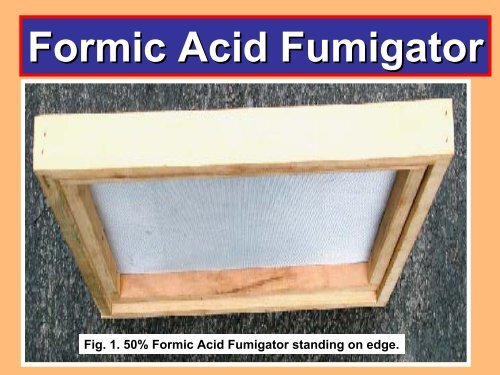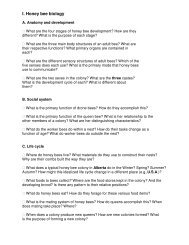Formic Acid Fumigator
Formic Acid Fumigator
Formic Acid Fumigator
- No tags were found...
You also want an ePaper? Increase the reach of your titles
YUMPU automatically turns print PDFs into web optimized ePapers that Google loves.
<strong>Formic</strong> <strong>Acid</strong> <strong>Fumigator</strong>Fig. 1. 50% <strong>Formic</strong> <strong>Acid</strong> <strong>Fumigator</strong> standing on edge.
Top View outside dimensions: 18” by 16 1/4” (45.72 x 41.275 cm)3/8” (1cm) bee wayAluminum flashing3/8” (1cm) bee wayFig. 2. Top View, Outside dimensions: 18” x 16 1/4” (45.72 x 41.275 cm).
Fig. 3. Bottom View.18” (45.72 cm)17 ½” (44.45 cm)BEEWAY = 3/8” (0.95 cm)16 1/4”(41.275 cm)14 3/4” (37.465 cm)12 1/2” (31.75 cm)Aluminum screen overabsorbent pad to keepbees from removing fibers.90 ml of 50% FA plus 15 ml HBH,is mixed and poured onto ellipseBEEWAY = 3/8” (0.95 cm)
½” (1.27 cm)7/8” (2.22 cm)3/8” (0.95 cm)
Bee WayDownALUMINUM FLASHINGABSORBENT PADSCREENFig. 5. End view detail.Queen SpaceQueen SpaceACTIVATION CAVITYACTIVATION CAVITY
Black = Al flashingBlue – Absorbent PadRed = Al screen1.25”activation cavityACTIVATION CAVITYHeat from BroodThe space [purple lines] below the Aluminum screen [red]is critical to the function of the fumigator. Heat from thebrood rises into this ‘activation cavity’; the heatcauses the 50% formic acid and HBH to quicklyevaporate, and the bees vigorously fan this formic-HBHvapor throughout the hive. In three separate experiments(Sep 01,2000) -10 hives each- when 5 or more framesof brood were present, the temperature in the brood nest was94° F, in the Activation Cavity - 92° F, and at the entrance -90° F. By noon the next day, virtually all formic acidhad evaporated and the fumigator was removed. Broodcells were opened and all mites were dead; no bee broodwere killed; only a very few varroa invading food at thebottom of the cell were still alive.Fig. 6.
Application:1. Ambient Temperature should be 60 to 90° F (15.5-32.2° C).2. Apply treatment between 13:00 & 18:00 (1-6 PM).3. Manage all brood frames in one or two brood chambers.4. Add 85 ml (2.8oz) of 50% FA solution to container, then15 ml (1/2 oz) HBH, mix thoroughly, pour onto absorbentpad in fumigator. Place above upper brood chamber.5. Tape all openings shut; if using screened bottom board,use solid Bottom Board or cover the screen with masoniteplastic or aluminum sheet.6. Reduce entrance to 3” x 3/8” (7.5 x 1cm) at center.7. Remove fumigator the next day between 12:00 & 18:00(noon and 6PM).In most cases, only one treatment is needed per season. We often gotwo seasons between treatments, depending on # of infested broodcells (and # of incoming mites from dying and/or wild colonies).Fig. 7
Fig. 8. Entrance cleat reduced to 3.5” x 3/8” (7.5 x 1 cm) at the center.Fig. 8.
Fig. 9. Results of Using the 50% <strong>Formic</strong> <strong>Acid</strong> <strong>Fumigator</strong>: top three pictures show initialtreatment on 09/12/2000. Bottom two pictures show second treatment on 09/28/2000OldStyle<strong>Fumigator</strong>Test Hive #5 Rick’s; 12Sep00.Results Hive #5, Rick’s. Close-Up Hive #5, 49 mites.Second Treatment 13 Days Later:Rick’s Hive #5 30, Sep 2000.Exploded View, 30 Sep 2000, 8 mites.
Video Results of Usingthe 50% <strong>Formic</strong> <strong>Acid</strong> <strong>Fumigator</strong>Video IDetector Board DemonstrationVideo IIMite Drop
90% FA50% FA WaterA simple way to estimate 50% <strong>Formic</strong> <strong>Acid</strong>: a cherry tomato sits about 2.5mmabove the surface of 50 % FA (center); sits 4-5 mm above the surface of 90% FA(left) and sinks in tap water (right) [23 March 2006].
Use Honey-B-Healthy® to Prevent Queen LossHBH contains spearmint and lemongrass essential oils.Two teaspoonfuls in a quart of 1:1 sugar syrup delivers atotal of one cc of both essential oils (0.5 cc each).Because we use the natural emulsifier, lecithin, the essentialoils are evenly distributed throughout the syrup.Honey-B-Healthy produces rapid build up of bees and (inour opinion) helps to reduce pathogens. However, Honey-B-Healthy alone does not significantly reduce mite numbers.It prevents queen loss when treating with 50% <strong>Formic</strong> <strong>Acid</strong>.It calms the bees. It also helps to introduce queens: sprayThe brood frames and queen cage with a little syrup containingHBH, and the bees will accept the queen in a directrelease with no chance of balling. It also helps to reducestings: sprinkle the bees and mix a little on your handsand watch the difference in bee behavior- - you will getvery few or no stings at all.
Constituents of Lemongrass OilLemongrass oil is purchased From INDIA:It is distilled from two Tropical Grasses:Cymbopogon citratus (DC.) StapfCymbopogon flexuosus (Nees) Stapf.Constituents: Citral (75-85%)MethylheptanoneCitronellalGerianiolLimoneneDipenteneOthers?Lemongrass calms and attracts the bees, much like the Nasanoff Gland.
Constituents of the Honey BeeNasanoff Gland:PheromoneNasanoffChemicalFunction:GeraniolOrientationNerolic <strong>Acid</strong> "Geranic <strong>Acid</strong> "(E)-Citral "(Z)-Citral "(E-E)-Farnesol "Nerol "Others? ?The underlined items are present in HBH.
Why Spearmint Oil?We tested many essential oils, from menthol and spearmintto wintergreen and thymol and many others. Spearminthad the best results in reducing diseased brood. However,Honey Bees took sugar syrup with spearmint slowly: takinga week to consume one quart of 1:1 sugar syrup.Bob did a lot of research to see if he could keep Spearmint,and find something to make it more attractive. For somereason, he tried Lemongrass Oil, and the rest is history.We have seen colonies take an entire quart of HBH (lemongrass+ spearmint) in just four hours. Why does spearminthave an impact on Honeybee health?This is pure speculation, but…a hypothesisWe think it has a parallel mode of action in Honey bees asto Tamiflu in humans; Tamiflu, oseltamivir, is part of a familyof flu-fighting medicines called neuraminidaseInhibitors, derived from Shikimic acid, obtained only from theChinese Star Anise, Illicium verum Hook f. Magnoliaceae.Fig. 1.
Typical Results:1. Varroa Mites are killed in capped brood cells aswell as on the bees.2. Detector boards show large mite drop for 13-14 daysafter treatment (time required for brood emergence).3. A few varroa mites in newly capped cells survivethe fumigation: they are found with larvae. Theyimmerse themselves in larval brood food at thebottom of the cell, and this protects them from theformic acid.4. Honey left above the fumigator does not absorbformic acid, which is dense (sp. gr.= 1.22) and sinks.
Cost for FA treatment using theBob Noel <strong>Formic</strong> <strong>Acid</strong> <strong>Fumigator</strong>.Cost of 15 gallons of 90% FA, about $100 ($142 with deposit).One gallon of 90%FA = $6.66 ($9.47).Dilution of 1 gal. to 50%, makes up about 1.8 gallons(6.81 liters).@ $6.66/gal. or $6.66/6.8 liters = $0.979 per liter.One treatment requires 90cc or .09 liters of mix,(.09*$0.979) = $0.088 (or $0.125) per treatment [cost of FA].One gallon of 90% FA [$6.66] will make 1.8 gallonsof mix at 50%, = 6.81 liters = 6,810cc/90 = 75.67 treatments.($6.66 / 75.67 = $0.088 or $9.47/75.67 = $0.125 per treatment)Source for <strong>Formic</strong> <strong>Acid</strong>: Chemicals & Solvents, Inc.,1140 Industry Ave., SE, Roanoke, VA;phone: 703-427-4000. They sell a 15 gallon, heavyplastic drum of 90% FA + $42 drum deposit for $142.
Cost of HBH Concentrate - eliminates Queen Loss(about 25% in hives treated with FA only.)A bottle of HBH costs $12.95, = 8 ozs = 237 ccWe add 15cc of HBH per treatment of 90cc of FA,= 12.95 / (237/15) = 12.95/15.8 doses = $0.82 per hive.One 8 oz bottle of HBH is sufficient for 15.8 colonies.One 16 oz bottle of HBH is sufficient for 31.6 colonies.Cost of Syrup [one quart of 1:1 Syrup]:Sugar: 1.1 lb/50*24.00 = $0.53/20 = $0.03 per treatment.Add 20cc HBH to 1 Qt of 1:1 syrup: (20/237)*12.95 = $1.09;1 Qt of Syrup does 20 hives ($1.09/20) = $.055 each.Total for HBH-Syrup: $.03 + $.055 = $0.085 per hive.Total cost of one FA treatment (less labor):FA $0.088 + HBH $0.82 + Syrup $0.055 = $0.963.After mixing with HBH, the final concentration of<strong>Formic</strong> <strong>Acid</strong> is about 43%. Fig. 1.
Will the honey bee become…. . . EXTINCT?Images from the web.








